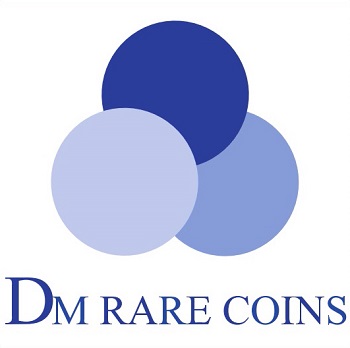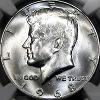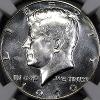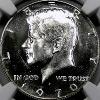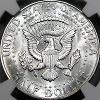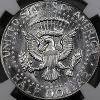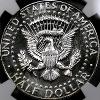Welcome to Our Blog!
Years 2018-2017
Find useful information, announcements, coupons, anecdotes, market reports, an educational Coin of the Month, and musings not suitable for our Research section.
December 31, 2018
DM Rare Coins Coin of the Month
December 2018
Rare 1949-S Full Torch Prooflike Roosevelt Dime Graded NGC MS67 FT PL:
Potentially the Finest Known 1949-S!
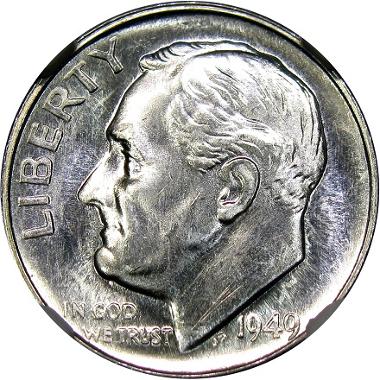
When the Full Bands/Full Torch designation was introduced for Roosevelt Dimes in the early 2000s, it quickly became apparent that 1949-S was the series key in FB/FT (PCGS uses FB, NGC uses FT). Over the past 15 years, we have handled a number of FB/FT Roosevelt dimes, but only two 1949-S pieces. The most recent example easily earns our Coin of the Month spot for December. This piece; graded NGC MS67 FT PL; is potentially the finest known 1949-S dime, period.
PL silver Roosevelt dimes primarily appear in the 1940s, and they are quite rare with fully PL surfaces. In MS67 FT PL, they are almost impossible to find. Thus, when you have a 67 FT PL that is also a 1949-S, you have something truly special, and quite unique, at least at this point in time!
Not only have no 49-S dimes been graded in MS68FT/FB, but this is the only piece in the 67FT grade to achieve the Prooflike designation. While there are about 20 normal MS67FT/FB pieces on the pop report for 49-S, this is a pop 1 in PL, and certainly the finest known Prooflike 1949-S. PCGS has graded just a couple coins in 67+FB. If you choose to equate the extra designation + with PL, both being a step above the regular 67FT/FB level, this piece is among the top three coins known. We prefer not to equate these designations, asPL is something separate from grade. This coin is in a column all its own (quite literally, when you look at the pop report). A home run piece that fully justifies our use of another PL coin in the Coin of the Month spot.
Happy Collecting!
Doug
DM Rare Coins
November 30, 2018
DM Rare Coins Coin of the Month
November 2018
Presently Unique Discovery!
1998-D Deep Mirror Prooflike Kennedy Half Dollar!
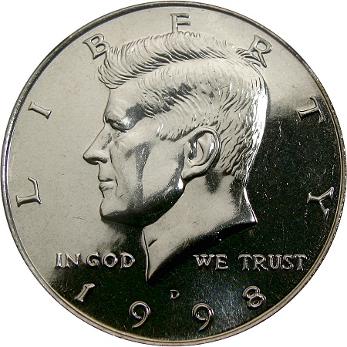
Very rarely is a Deep Mirror Prooflike Kennedy half dollar certified, and almost never do they come up for sale. We are not talking about the 2014 "Enhanced Finish" coins, which were mass produced with intentional, hybrid Proof characteristics. Such coins are common and have no added value beyond the going rate of that issue. You can count on your fingers the number of authentic, Business Strike, DPL Kennedy Half Dollars that have been found. The featured 1998-D easily earns our November Coin of the Month spot because it is both a pop 1, new discovery and tied for the finest DPL Kennedy certified. DPLs are only known for 1970-D, 1989-P, and now, 1998-D.
While some standards of measurement are observed when determining a PL coin, there is typically no measurement required to spot a DPL Kennedy Half dollar. The large, broad fields will show outrageous, deep, watery mirrors that pick up everything around them, often from feet away. Reflections roll over the fields like mini tsunamis, and the dancing luster absolutely looks alive. These coins pop out at you, and there can be no question about what they are.
Speaking of large broad fields, this piece is an exceptionally high-grade for a DPL, having earned an MS66 DPL grade at NGC. Prooflike and Deep Mirror Prooflike luster is very delicate, and the tiniest marks can greatly affect the grade. It is a minor miracle that such a large, fragile coin has survived in MS66. Of the 9 DPL Kennedy Half Dollars known, of all dates, just two have been graded MS66DPL, with none finer. Therefore, this 1998-D is tied with a 1989-P as the finest known Deep Mirror Prooflike Kennedy half dollar.
Happy Collecting!
Doug
DM Rare Coins
November 11, 2018

At 11:11, on the 11th day of the 11th month, 100 years ago, The Great War, i.e., The War to End All Wars, ended abruptly, with advance notice. There has been virtually no attention paid to the Centennial of WWI, which is happening today. This is ironic considering the origin of Veteran's Day, once called Armistice Day, was the end of WWI, in the first place. Granted WWI was one of the most absurd monstrosities ever conducted by mankind; a cat fight between relatives, enacted on the World Stage; but at the time it must have seemed important enough to loose 20 millions soles. And, of course and as usual, America came in and put an end to it.
Therefore, we celebrate the heroism and patriotism of the tens of thousands of dough boys who fought and died to restore piece to the world in 1917 and 1918.
The arbitrary Armistice was agreed upon hours in advance, and rather than ending it upon the agreement, both sides decided to have some fun and end it at 11:11:11am. In the meantime, hundreds of men were killed as fighting continued for the 6 or so hours leading up to 11:11am, as both sides tried to jockey for better field position before the clock ran out (really). Again, one of the most absurd monstrosities ever conducted by mankind.
Upon the return of American troops, towns around America began to erect monuments to the dough boys who fought and won the Great War. The First Armistice Day was observed on the 1 year anniversary, November 11, 1919.
October 31, 2018
DM Rare Coins Coin of the Month
October 2018
1957 PF67* (STAR) Franklin Half Dollar Shows
More Than Meets the Eye (Appeal)
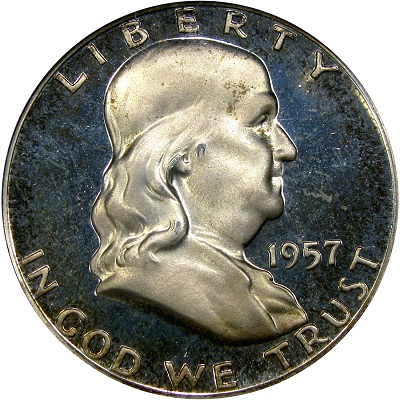
Our featured coin of the month is a very cool 1957 Proof Franklin half dollar, graded PF67* (STAR) by NGC. The coin is totally original and completely un-messed-with. It has a delightful halo of russet and deep green speckles around an otherwise tan gold obverse. The fields are deep and dark, and the high points are caked with as much luscious frost as physically possible. On the other hand, the reverse is totally brilliant with hard, glossy surfaces that are barely mirrored, and only the faintest trace of Cameo on some of the lettering. The toning is just a light haze. There could not be more contrast between obverse and reverse.
This piece demonstrates three important things. First, the Mint only cared about the quality of the obverse die. Second, the Star designation, which is often used to denote a coin with Prooflike or Cameo only on the obverse, doesn’t always tell the whole story. And third, the delicate nature of Proof (and also Prooflike) luster causes the surfaces to tone differently than non-Proofs and non-Prooflikes.
We have demonstrated time and again, in our studies on specific dies, that the Mint largely cared only about the quality of their obverse dies. The replacement of obverse dies is often observable, while the reverses were simply allowed to wear out. Such was the case with our 1947-S RPM FS-501 die progression study, for example. Back to the coin at hand, this gorgeous, brand new, DCAM obverse die was paired with a well-used, lifeless reverse die in order to make this 1957 Proof half dollar. Even in a made-for-collectors Proof set, the Mint was not concerned about this miss-matched pairing.
This piece also demonstrates that there are varying degrees of Cameo, and in turn that the Star does not distinguish between them. This coin has a Deep Cameo obverse and it got the NGC Star Designation. Yet, if we had another 1957 that only had a Cameo obverse, it would still have received the Star designation. There would be no way to tell, based on the label, that there is a difference between the two coins. That means it is essential to look closely when you see a Star, to figure out what qualities the coin actually possesses. The value of this coin is somewhere between that of a Deep Cameo and a brilliant coin, not somewhere between Cameo and brilliant. Knowledge is power.
Finally, this piece was clearly stored in its original packaging, which would have exposed each side to roughly an equal degree of environmental factors. And yet, we see two very different types of toning between obverse and reverse. The reason for this is actually simple; Proof coins (and Prooflike coins, for that matter) have a more complicated microscopic structure than regular coins. The stronger the mirrors, the more fragile the surfaces. Added microscopic surface area results in a greater ability to oxidize. That is the best description my non-trained scientist mindcan give to describe what’s going on here. On this coin, the obverse is deeply mirrored, but the reverse is barley mirrored at all. The delicate Proof surfaces of the obverse were more susceptible to oxidation, resulting in rich toning. The same exposure to sulfurous materials only resulted in a ring of cloudy haze on the hard, barely reflective surfaces of the reverse.
Who thought there was that much to see on a Proof Franklin. I told you this was a cool coin!
Happy collecting!
Doug
DM Rare Coins
September 30, 2018
DM Rare Coins Coin of the Month
September 2018
Rare 2017-P Pocket Change Find!
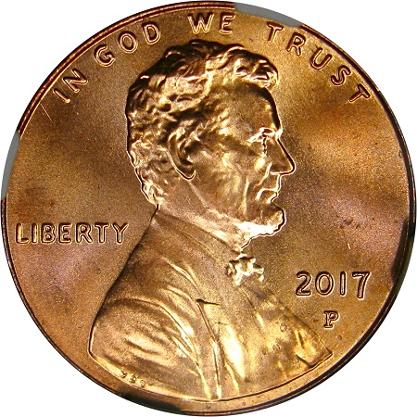
If you’ve been reading our educational blog posts, you are probably thinking, “Really? Another 2017-P cent makes Coin of the Month?” Well, yes it has, but this is a post that goes beyond the coin at hand. Our feature article goes to a coin I found on the ground; ostensibly a common 2017-P cent. (We have already discussed the importance of this issue, being the only cent from Philadelphia ever to carry a mint mark. Read our January 2017 announcement for more on that.)
At least I thought it was a common cent when I scooped it up off the floor at the mall. I always pick up “pennies” when I see them laying around. It makes no economic “cents” these days to pick them up; I just do it for fun. Actually, I never turn down the opportunity to look at a coin. Having worked in retail, I know there are many people who actually prefer to throw their cents on the ground, rather than place them in their pockets. I will now detail one reason why this is foolish.
I was in quite a hurry that day, and while I did stop to pick up the coin, I did not have the chance to look at it until days later when I was doing laundry and it fell out of my pant’s pocket. At that time, I discovered it to be a bright and shiny gem, Red 2017-P! Great, but I got quite the surprise when my coin-grading reflexes habitually turned the coin over, in order to examine the reverse. I found something to be askew.
The coin is a major Mint Error! For many years, this was referred to as a Rotated Reverse. The reverse die became loose and turned out of proper alignment. The reverse, or hammer die, strikes the coin, while the obverse die serves as the anvil, a stationary plane that absorbs the impact. This arrangement is supposed to result in a consistently sharper strike on the all-important obverse, but the reverse is prone to rotation. Today, however, these are more correctly referred to as Rotated Dies, because it is hard to say which die actually rotated out of position.
This piece ultimately graded MS66RD Mint Error Rotated Dies, at NGC. Being a special 1-year issue, this Error is particularly appealing, and we would place the value of something like this around $300, if it were going up for sale. This free pick-up coin resulted in a very cool and potentially unique find. Why aren’t you picking up the pennies you see laying around?
Happy Collecting!
Doug
DM Rare Coins
August 31, 2018
DM Rare Coins Coin of the Month
August 2018
DISCOVERY PIECE:
Thin Planchet 1876 HK-854 Dickeson Continental Currency
Prooflike"Die Trial?"
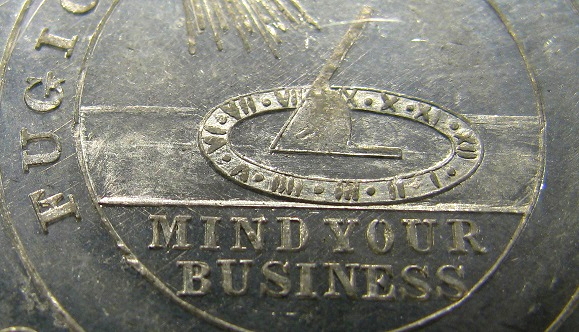
In light of our research into the Dickeson medals, our Coin of the Month slot went, hands down, to this new find. We recently discovered an original 1876 example of Dickeson's Continental Currency Dollar, HK-854, in White Metal, which was struck on unusually thin, 2 mm thick planchet.
All original examples were previously though to be between 3 mm and 3.4 mm thick, and that measure has long been considered the diagnostic for identification and differentiation between originals and later restrikes. All but the seasoned experts would assume this 2 mm piece was merely one of the numerous modern restrikes.
However, the early die state, with full table top details, thick rims, fat, connected beading, orange peel textured Prooflike fields, and Cameo contrast proves this to be an original 1876 version. The thin planchet could either be because this was an experimental Die Trial, or because it could have been part of an early batch of thinner medals that were subsequently discarded in favor of thicker examples.
Regardless of its why it exists, it does; and HK-854 can no longer be identified strictly by its thickness. This is imperative information that medal collectors and So-called dollar enthusiasts need to know.
Please see our full feature article:
Thin Planchet 1876 Dickeson Continental Currency Dollar Discovered: Possible Die Trial HK-854 Changes the Standards for Identification
We also recommend reading our sister article on the HK-853 for additional information, though this discovery makes some of what we said there obsolete. We will be revising it slightly in the coming days based on the new Discovery Piece.
Happy Collecting!
Doug
DM Rare Coins
July 31, 2018
DM Rare Coins Coin of the Month
July 2018
1944-D Walking Liberty 50C
With Re-Engraved Obverse Design & Obverse Doubling!
Recently, collectors have become more aware of the existence of re-engraved dies; i.e., coins that show re-cut design features. The Mint would sometimes take a used die off-line, and then an engraver would hand-cut new details into the die steel to replace weak or missing design elements. A few of these re-engraved die varieties have found their way into the Cherrypicker’s Guide, including the 1957-D Re-engraved tail feathers Washington Quarter and the 1944-D Re-engraved AW Walking Liberty half dollar. Many more have not yet been properly recognized, and instances of re-engraving occur on coins of the 1940s and 1950s; a time when the Mint was apparently more concerned with economy than quality. One of these unknown varieties is yet another 1944-D Walker; but this one has a re-engraved sun and earth! A highly polished obverse die had lost its fine detail, and Mint workers crudely re-engraved portions of the design with a hand tool. This cool coin was an obvious Coin of the Month candidate for the July spot.
This piece was advertised to us as a Prooflike Walker in PCGS MS65, so naturally, we jumped at the chance to get it. We discovered, upon delivery, that the coin is in fact struck from the distinctively polished dies, of the “the Prooflikes of 1934 to 1955” variety. However, it was more of a middle die stage comparable to stage D of our analysis of a PL die. The mirrors of the obverse had begun to fade away and it would be considered Semi-PL, at best. The reverse die also shows traces of the tell tale crisscrossing die polish, but is an even more advanced die state, with no PL qualities. Thus, we were left with a gem Walker with a Semi-PL obverse.
Our initial disappointment lead to newfound excitement when we began a cursory examination under a glass. An immediate observation revealed something that looked like a tripled or even quadrupled image on the last ray on the right side of the sun. These markings turned out to be long, hand cut lines. Someone had carved into the die steel to strengthen the design in multiple places, including some of the sun's rays. Parts of the sun’s rays, the clouds, and the ground below Lady Liberty, and some of the lower skirt lines showed traces of re-engraving, and heavy die lines run the length of the horizon.
Click to enlarge high-resolution images!
One can surmise the reason for this enhancement; because this obverse die was heavily refinished with coarse abrasives, and then finely polishing, some of the more delicate details had simply come up missing. Then, someone broke tradition and decided to put those missing details back, by hand, using an engraving tool. Perhaps it was the same Mint worker who re-cut the famous 1944-D Re-engraved AW half dollar, where the Mint polished off the AW and added it back in by hand-carving a new monogram. It is the same Mint, the same year, and the same denomination, after all.
We also realized, but were not surprised, that the obverse might actually be the discovery piece of a new Doubled Die, (we are awaiting official confirmation of this). In two or three places, a second image is seen, protruding from behind the primary image. During our extensive research of the PL coins of 1934 to 1955, we have often foundthe affected dies to be either Doubled Dies or RPMs. Perhaps an explanation of the mysterious finish has to do with the removal of such manufacturing defects? Consequently, we always look over these Polished PL coins carefully for die varieties.
Click to enlarge DDO image!
The present specimen is thus a Semi-Prooflike, Gem-grade, Re-engraved Die, Doubled Die Obverse. That would be a mouthful, if PCGS were ever to add it to their list of varieties they recognize. In the meantime, maybe you can find one too, or a new variety that deserves recognition.
Click to enlarge full gallery!
Happy Collecting!
Doug
DM Rare Coins
June 30, 2018
DM Rare CoinsCoin of the Month
June 2018
1939-S Rev of 1938 NGC MS65PL; Rare, Prooflike, Early Jefferson Nickel!
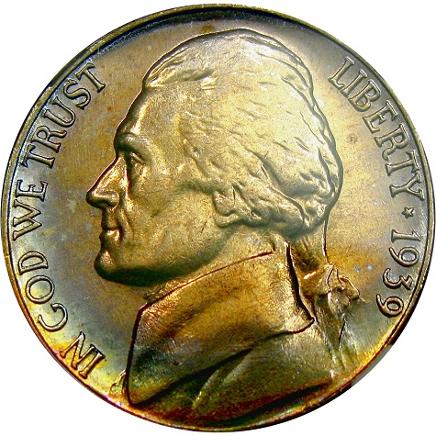
As we have discussed many times before, both on our blog and in our original research articles, the Prooflikes of 1934 to 1955 display a unique finish in Numismatics. Examples from the 1930s are very hard to come by; and nickels are probably the scarcest of any denomination to feature the phenomenon. Thus, we jump at any opportunity to display one. Thus our June 2018 Coin of the Month spot goes to a gorgeous 1939-S Jefferson nickel with gleaming, glass-like fields over both sides, and the crisscrossing polishing lines that define this finish. The mirrors do not show up in the images.
Without delving too deeply into the theories behind the appearance of these mysterious PL issues (more on that can be found in our research tab), suffice it to say that Jefferson nickels are neck and neck with Wheat Cents, vying for title of the scarcest denomination to show the polished PL finish of 1934-1955. Only a handful of nickels have appeared in the NGC population reports, and these are almost exclusively S-mint coins (also typical of the era).
NGC Coin Explorer comments that the 1939 pieces sometimes display "crude die polishing lines in the fields" (1). The coins they refer to are regularly encountered in the marketplace. They are actually the common, later die states of dies like this one. Almost as soon as the freshly polished, PL dies are used, they begin to erode. The fine die lines seen here become more pronounced, and even heavy and coarse, as the mirrors quickly dissipate and change over to frost. It is actually a strange phenomenon to observe, but we have documented it in some of our articles. The mirrors did not last very long, at all, before heavy die lines kicked in, so it makes perfect sense that the graders would describe many of these pieces as crude. The glassy mirrored coins are the exception.
Our featured specimen is clearly special because of its finish, but moreover, because it is a gem and that is lined with beautiful rainbow album toning. This is what collectors would call a home run coin. Of course, these pieces are so rare in PL that they are almost what they call un-collectible. This is the only piece certified by NGC for the 1939-S Reverse of 1938. They have slabbed one Reverse of 1940 example, an MS66PL. There are of course no P-mint examples (the Polished PL finish is virtually non-existent on Philadelphia issues), but there are also no D-mint pieces graded. Actually, there are only four PLs graded for all 1930s Jefferson nickels, and all are San Francisco.
For more information on the Polished PL finish of 1934 to 1955, please see the original articles under our research tab, HERE.
Happy Collecting!
Doug
DM Rare Coins
Bibliography
NGC Coin Explorer: 1939 S Rev of 38 5C MS. https://www.ngccoin.com/coin-explorer/jefferson-five-cents-1938-date-pscid-25/5c-1939-s-rev-of-38-ms-coinid-514006
May 31, 2018
DM Rare Coins Coin of the Month
May 2018
High-grade 1836 Capped Bust 50C O-106A
Beaded Border Reverse Experimental Design Type!
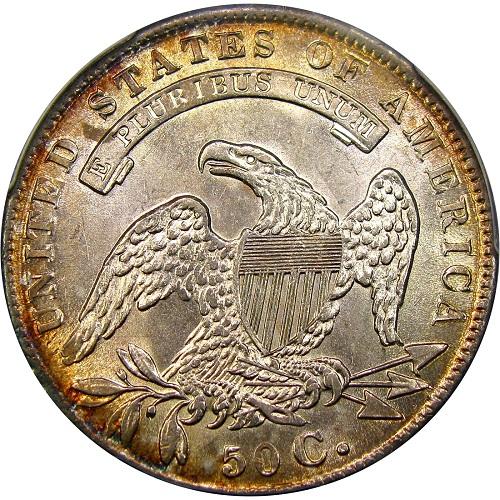
This is a Coin of the Month we've dreamed of writing about for a long time, but we simply have not seen the right coin. It's no secret to Early U.S. half dollar collectors that we are obsessed with the 1836 O-106A Beaded Border Reverse die variety. We've handled numerous examples in VF, XF, and sometimes AU grades. This is the first time we have seen one that looks Mint State, and because of its exceptional condition, it demonstrates full, as-struck details on the reverse rim, and is thus an excellent study piece.
First it should be understood that examples of this variety are almost never struck with full border details, so even MS coins are not always complete. Further, a few Proofs were struck from this die marriage, and they do not show complete borders either. Perhaps it was the incomplete, sometimes indistinct details that allowed this amazing, but largely unknown die variety not to receive its due attention?
The 1836 Beaded Reverse Border is a unique design sub-type, seen nowhere else on the Early half dollars of 1794-1836. This is for good reason, as the Beaded Border was designed to be used on close-collar presses, with steam power, which did not appear until the end of 1836.
The Beaded Reverse border coins were all struck from a single die pair. Curiously, the reverse showed bead decorations encircling a raised rim, rather than the traditional dentil rim seen on all other Early half dollar dies. Even the obverse die of this marriage shows a regular dentil rim, in contrast to the reverse.
The die marriage is listed by Overton as O-106, but speaking of being under-rated, Overton strangely missed the beaded border completely, despite his attention to other minute details that identify the marriage. If not for this variety being included in the Redbook for a number of years, it is likely no one would know it exists! Another problem with Overton's analysis is that there are clearly three die states, where Overton only defined two. The first stage shows no die cracks. The second stage shows a large crack running up from the lower rim, through the arrow heads, and into the eagle's body. Finally, a third stage shows an additional crack from the right side, through the C in AMERICA. On the third stage, there is also a lengthening of the first crack, which now runs all the way through the eagle and above his head, stopping just beneath the scroll on the reverse. Overton's O-106A die state encompasses both of the cracked stages. The scarcest stage seems to be the third stage.
The die state does not seem to matter in terms of definition in the beaded border. Our host coin is the late middle stage, with one crack through the arrow heads, and perhaps just a faint trace of the third crack through C. Yet, it shows fairly nice beading compared to the average example. We have seen stage one examples with less beading definition. High grade is really what makes the difference in the rim detail on this variety. That said, few examples of this variety, from any stage, show complete details on the reverse rims, as this rim treatment was not designed to be used on open collar strikes.
The Beaded border reverse typically shows indistinct, stretched beads around a raised rim. The later die states show a die crack through the arrow heads, and then another through the C in AMERICA.
1836 was obviously a transitional year for the half dollar; the Mint switched half dollar production from screw press and open collar, to steam power and a close collar. The latter would impart a reeded edge at the time of striking, replacing the old lettered edge that had to be added through a separate process. The Capped Bust design was subsequently reworked to accommodate a necessary change in planchet size and thickness. In so doing, the traditional dentil rim was replaced with a raised, beaded border that would better accommodate the standard diameter on these new "Reeded Edge" halves.
However, the Mint had already coined 6,545,000 halves that year in the now obsolete open collar screw presses. And somehow, during that production run, one reverse die was cut using the new beading around the old design, which was subsequently struck in an open collar screw press. As a result of this mismatching of technologies, the reverse rim was very inconsistently rendered. Instead of metal hitting a close collar and being forced up, into the beading and raised rim during striking, there was no collar to contain the squeeze, and the planchets were allowed to expand beyond the diameter of the beading, creating a stretched appearance to the beads. The effect almost resembles dentils. Even the rare Proofs struck from this marriage show incomplete or distorted beading.
The presence of Proof examples helps to confirm that this reverse die was likely an experiment, manufactured to test the new beading pattern before the new designs, presses, and technology were implemented. If that was the case, it’s clear that the experiment failed. Substantially better results were achieved when the close collar, Reeded Edge halves were struck, and the Mint never looked back to the old, now obsolete, open collar.
The present piece shows full, unbroken luster across the fields, and powerful, glittering frost accented by light, iridescent toning. We expected an MS62 grade, think it would be held back from Choice because of a few parallel handling lines on the obverse. Nevertheless, it graded AU58 at PCGS. The strike is also superb for the issue; O-106 often comes flat, or lacking in fine details on the central obverse hair curls. Conversely, the reverse center is always well-struck and well-protected by the high, awkward rim treatment. That said, the featured piece is as well-struck as the marriage comes with bold, rounded hair curls on the obverse.
Just a handful of these are known in AU58 and any MS grade. Therefore, this highly detailed survivor really stands out from the heard and earns our coin of the month spot.
While the coin of the Month spot is educational, this particular item is currently available for sale in our Inventory!
Happy Collecting!
Doug
DM Rare Coins
April 30, 2018
DM Rare Coins Coin of the Month
April 2018
1947 Thomas Edison Centennial C. Smith So-called Half Dollar
Rare NGC MS66DPL
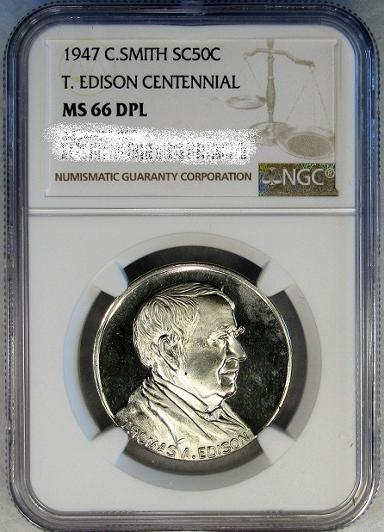
So-called half dollars, like so-called dollars, are simply privately struck medals; and like so-called dollars, which happen to be dollar-sized, the so-called halves happen to be about half dollar-sized. There were eight so-called half dollars struck on behalf of C. (Charles) Smith in 1947 and 1948, by the illustrious Whitehead & Hoag Company. The medals were originally issued in custom printed Wayte Ramond coin boards for collectors. These medals cover a range of interesting topics, such as the Confederate Seal, Charles Lindbergh's 1927 flight, and the Pony Express, to name a few.
The present Coin of the Month spot goes to the C. Smith Thomas Edison Centennial medal. We have handled examples of this issue before, and while examples of the various C. Smith issues can be found in Prooflike, it is very infrequent that they are certified with the DPL designation, as has this piece.
Many C. Smith pieces typically show fields with lots of frosty luster and sometimes semi-glossy luster. A number of them are fully Prooflike, with unbroken, mirrored fields on each side. On rare occasions, they have been found with deep mirrors and thick Cameo frost; these are the Deep Mirror Prooflike (DPL) pieces, like our featured Edison. Sharp, fresh engraving is enhanced by intense, extra-strong mirrors, which give way to virtually full Cameo frost over the devices of both sides. These DPL examples represent the design as it was originally intended, and they look quite a bit different than dothe later die states.
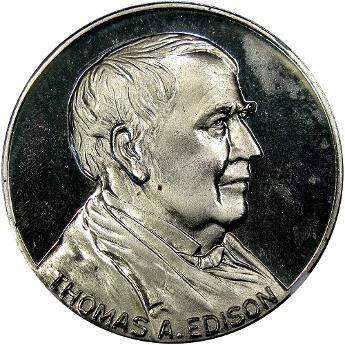
Deeply Mirrored, Cameo DPL
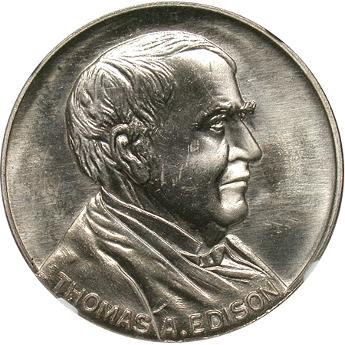
Frosty, Polished,Late Die State
The Thomas Edison issue tends to be rather scarce in gem+ condition, due to the high relief portrait and the broadly exposed, open fields of the obverse, which are very susceptible to contact. Thus, it is no surprise that this unusually nice MS66DPL is tied with one other as the Finest Known to date. It is a no-brainer for our Coin of the Month.
There are some other curiosities which draw us to the C. Smith Thomas Edison issue, in particular. First, the reverse is a noticeable Doubled Die, showing best on the S in THOMAS, and the 9 in 1947. This does not add extra value because all examples were struck from the same dies, and thus all are, in fact, Doubled dies. But it is a curiosity.
The other curiosity is the Thomas Edison portrait. Smith's portrait of Thomas Edison bears a striking, if not an uncanny resemblance to modern actor, Ciaran Hinds; best known for his role as Julius Caesar in the HBO/BBC series, Rome; and as King of the Wildlings, Mance Rayder, in the HBO series, Game of Thrones.


Bibliography
Image of Ciarian Hinds courtesy of The Movie Database. https://www.themoviedb.org/person/8785-ciar-n-hinds
Late Die State Edison obverse courtesy Northeastcoin.com.
Happy Collecting!
Doug
DM Rare Coins
April 14, 2018
Happy Tax Day!

To celebrate this rough and tumble time of year, we are offering our popular 6% Off coupon, available for all purchases, through the end of April!
You must use code:
TAXREFUND
Doug
DM Rare Coins
March 31, 2018
DM Rare Coins Coin of the Month
March 2018
1908 No Motto $10 Indian Gold Eagle
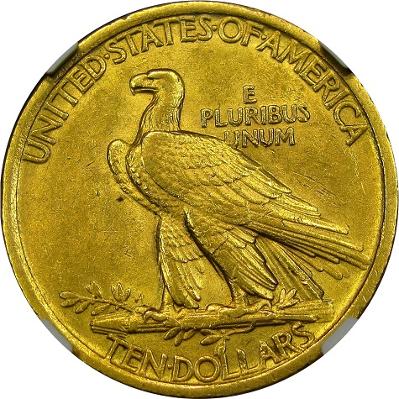
With the exception of a few experimental types struck in 1907, there is only one other, truly regular issue Indian Eagle; 1911-D, at 30,100; with a mintage lower than the 33,500 of the 1908 No Motto. And yet, there are several other dates, some with mintage figures that are nearly double, but which command higher premiums than the 1908 No Motto. This issue is notoriously under-rated, and in past years, has frequently traded for little premium over the price of a generic date. The 2017 Red Book, for instance, lists the price of an Au50 at $875, while the price of the 1908-D No Motto, with its 210,000 mintage, at $850 in Au50.
Sure, some other dates may be scarcer than their mintage figures indicate, due to low survival rates and mass melting. Yet the appearance of this issue on the market is infrequent enough to assume its survival rate is not great either. Very infrequently, one comes up to auction, and results are mixed. The 1908 No Motto is actually a forgotten issue.
When Augustus St. Gaudens began his redesign of the U.S gold coinage in 1907, Theodore Roosevelt was President, and he opposed the frequent usage of IN GOD WE TRUST on the national coinage, which the Red Book explains, is the reason for its absence on this design (1). Some 239,406 pieces were struck with no motto, in 1907. Congress took swift action, in 1908, to restore the Motto to US coinage; and the conspicuous, almost planned gap in the left field, on the reverse of this design, was soon home to IN GOD WE TRUST, where it remained through 1933. Only 33, 500 No Motto Eagles escaped the mint before the change, and some 341,370 were struck with In GOD WE TRUST. Because a 1907 No Motto is common, most Type collectors who needing one piece without the Motto and one with the Motto opt to fill that whole with a 1907 No Motto, leaving the rare 1908 No Motto only to the whims of the advanced collector.
In the past two years, with many classic coins trading at melt, new demand for gold rarities has allowed such coins as the 1908 No Motto to enjoy a better following. One could argue that the curiously low mintage, alone, should draw some extra attention to it as a conversation piece. In fact, auction records have climbed for choice examples, compared to decreasing prices for the Motto issues. Therefore, our March Coin of the Month goes to the wonderfully original, green and rose gold 1908 No Motto we recently acquired. This piece is just the second one we have handled, and serves as a reminder of the under-rated classic gold coins on today's market.
Bibliography
Yeoman, R.S. A Guidebook of United States Coins. Bresset, Bowers, Garret ed. 70th Edition. Atlanta, Whitman Publishing, LLC 2016. p277-278.
Happy Collection!
Doug
DM Rare Coins
February 28, 2018
DM Rare Coins Coin of the Month
February 2018
1952 Proof "Bugs Bunny" FS-403 Franklin Rarity!
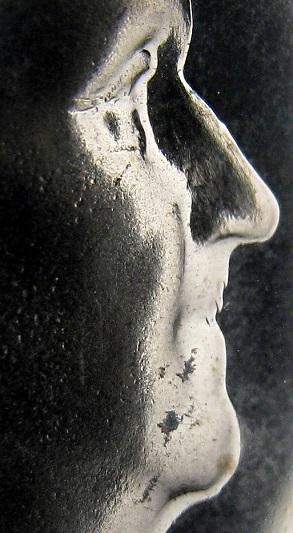
When we, along with several other Franklin enthusiasts, began putting together our lists of Franklin varieties for the 2012 Cherrypicker's Guide, we had a lot of very cool "Bugs Bunny" clashes, but no one had ever thought to look at Proof Franklins for this phenomenon. A few years ago, a collector discovered a few 1952 Proof Bugs Bunny Franklins, they were immediately picked up by the Cherrypicker's Guide (with an FS-403 designation), and the hunt was on!
To date, there are still just a handful of these known, but grades range from PF67 to PF64, as many of these have been certified for years, with the clashing going completely unnoticed. Proof coins are not supposed to be released with minting errors such as this. Proof dies are specially prepared and polished, the blanks are specially treated and polished, and the coins were supposed to be carefully struck and eventually placed into small cellophane bags, which were stapled together and placed into a cardboard box, to be mailed to collectors.
One can only speculation as to how such a dramatic die clash could occur on a Proof half dollar. Yet, examining a handful of 1952 Proof halves, it is obvious that quality standards were not what they had been in 1950 and 1951, or 1953 and 1954, for that matter. Many 1952s are struck from well-worn dies that probably should have been rejected and replaced. It looks as though mint workers were not concerned with quality standards, which is strange, considering 1952 had such a low mintage, compared to other dates. At least one die shows the upper lip completely polished off; possibly a late die state of the Bugs Bunny die, as mint workers often tried to remove the clashing damage around Franklin's mouth when it was discovered. Some 1952 halves also show re-engraving on Franklin's hair, restoring details lost due to polishing and die fatigue.
Occasionally, a 1950 or a 1954 Proof will show signs of die clashing, but to date, we have not been able to document any "Bugs Bunny" teeth on Franklin's mouth. There could be one out there somewhere, waiting for a careful pair of eyes to spot it. We can all but guarantee there are more 1952s to be found, though it will continue to be a rare coin, in our estimation.
Happy Collecting!
Doug
DM Rare Coins
Happy Presidents Day!
From DM Rare Coins
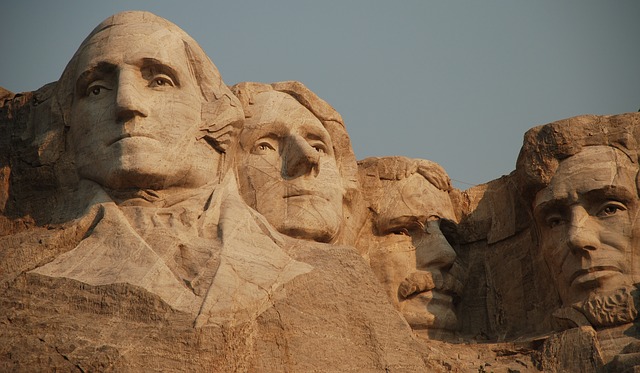
President’s Day is sort of an odd holiday, today. It typically falls somewhere between Lincoln and Washington’s birthday, but purports to be a celebration of all U.S. presidents. Yet, those of you old enough to remember a simpler time, and those who are students of history, know Presidents Day used to be called “George Washington’s Birthday.” School children were taught about the Father of Their Country’s cherry tree, his impeccable honesty, and that his birthday fell on February 22, 1732.
What most did not learn is that George Washington was actually born on February 11, 1731! The discrepancy arises from the fact that the Julian calendar that we use today was not implemented by the British government and its colonies until 1752. Prior to that year, the Gregorian calendar was standard. It ran 11 days behind the Julian, and each year began in May instead of January. The rising popularity of the more sensible Julian calendar can be seen in Mid-18th Century documents, and even ephemera like medals, that refer to the January through April months with a split year, in order to reflect both calendar years. On this Admiral Vernon Medal, compliments of Heritage, the date is written “1740 : 1,“ to commemorate a battle which, today, we understand as having occurred in March of 1741.
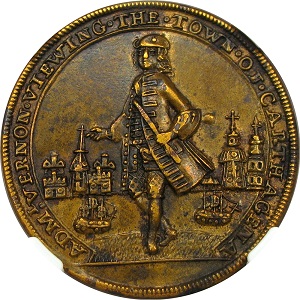
Ultimately, the change in 1752 was a welcomed one, but George Washington continued to celebrate his birthday on the 11th of each February; just one day behind Lincoln’s!
Happy Collecting!
Doug
DM Rare Coins
January 31, 2018
DM Rare Coins Coin of the Month
January 2018
RARE 1877/7-S Re-punched Date Trade Dollar!
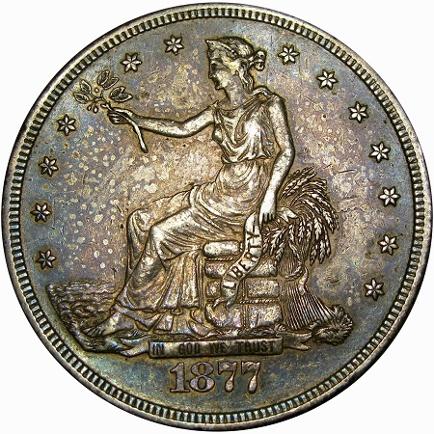
There are a couple interesting and well-known Doubled Dies for the 1877 San Francisco Trade dollar, but there is also a very cool, yet largely unknown Re-punched Date. The 1877/7-S Re-punched Date is actually documented in the Cherrypicker's Guide as RPD FS-301, but so few of them have been found that it is seldom collected.
The second 7 of the date is noticeably recut over a very sharp, original impression that was punched too low. The serif appears widely doubled because of these clear, overlapping 7s, and the rounded, extra stand drops down bellow the primary, again with no signs of an attempt to removed the first 7. This variety is very enjoyable to examine; it is a wonder why the mint worker's did not try to file or polish the obvious first 7 away, as would typically be the case with such an engraving blunder.
PCGS has certified just 10 examples in all grades, and NGC does not list a single example in their Census. CoinFacts shows just one piece coming to auction, back in 2013. Because we have been unsuccessful in finding one of these until now, despite lots of searching, our January Coin of the Month necessarily goes to the first RPD FS-301 we have come across, in any grade. The coin itself is an original AU with rich toning, underlying luster, a sharp strike, and delightful blue, rose, and amber hues working in from the peripheries. It will soon become the 11th certified at PCGS. Great coins are out there; it's time to start your hunt!
Happy Collecting!
Doug
DM Rare Coins
Wishing You
a
Happy New Year

from DM Rare Coins
November 30, 2017
DM Rare Coins Coin of the Month
November 2017
1886-S/S $5 Rare Liberty Half Eagle RPM Variety!
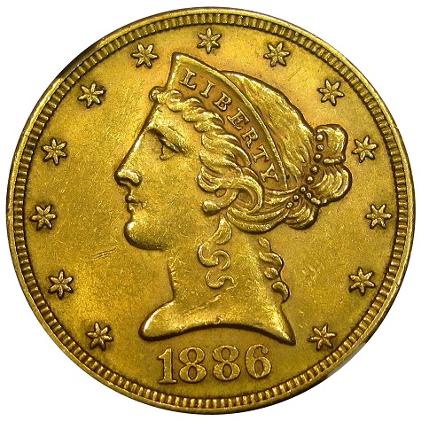
Die varieties for Classic U.S. gold coinage are only recently becoming popular. It used to be that the high price of gold would effectively limit any extra premium collectors would pay for die varieties, over their run-of-the-mill counterparts. Within the past 5 years, however, collector premiums for Liberty gold coinage have all but completely dissipated. Due to the historically high price of gold these days, dealers are treating Liberty gold as little more than bullion, and collectors are looking for new reasons/excuses to collect Liberty gold coinage and make their collections stand out from the ordinary. One such excuse is to collect those previously ignored die varieties.
With some spectacular varieties out there, it is hard to believe they have been ignored for so long. Though improvements are made with each new edition, The Cherrypicker's Guide is woefully behind the times in documenting gold varieties. Further, PCGS will only recognize varieties outlined by the Cherrypicker's Guide. On the other hand, NGC is perhaps leading the way forward by adding new discoveries to their proprietary Variety Plus catalog. An impressive list is developing there.
Our featured Coin of The Month is a delightful, original, mint state, 1886-S Liberty gold Half Eagle that displays a clear and all but unknown RPM. Sharply defined fragments of another S punch are easily seen to the southeast of the primary S, and there is a wide notch seen at the upper serif. Currently, there is no RPM FS-501 designation for this die variety, as it is still not listed in the Cherrypicker's Guide. This RPM can only be found in the NGC Variety Plus catalog, and it should be noted that just four coins have so far been found (this piece soon to become a fifth).
Another consideration for collectors wanting to set their collections apart from the ordinary is paying attention to originality. Most classic gold has been stripped and conserved. The present specimen is richly toned in green and rose gold hues and has never been dipped or otherwise brightened to expose the underlying golden shine of your average bullion round. This is a supremely appealing half eagle. The strike is also impeccable, and the surfaces are quite nice for the MS62 grade assigned. Perhaps we should have cleaned this one to get a 63 or better? No! I think it's just fine the way it is :)
Happy Collecting!
Doug
DM Rare Coins
November 24, 2017
The Laurel Highlands/Nathaniel Greene Hoard of
U.S. Coins and Paper Money
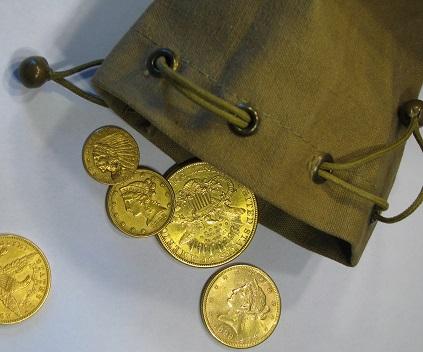
We are pleased to announce the acquisition of a notable, turn of the 20th Century coin hoard. The coins were accidentally stumbled upon, hidden in the walls of an old family house, inside an antique wooden box, in a historic Western Pennsylvania town, which is Nathanial Greene’s namesake. The paper money was largely stashed in old greeting cards that were put away in the drawers of a wooden chest in the same home, and miraculously never spent. The quality and variety of the small hoard is impressive. The earliest coins date to the 1820s, and the newest paper money to the 1920s. About two dozen untouched, pre-1926 gold coins were contained within a canvas bag, and many of them have that desirable “green gold” patina rarely seen on today’s processed and conserved gold coins. Dozens of 19th century copper and nickel pieces were found, as well as Bust and Seated silver coinage of all denominations. There are 54 currency notes, including an 1864 Confederate $50 note with a family lineage, and early silver and gold certificates. Finally, included in the hoard is some junk silver that was certainly saved at a later date. This will be divided into lots. We look forward to offering up these classic coins and notes to our customers. Many raw coins will be posted to our website over the coming weeks. Higher-end coins and currency will be certified and should arrive back in December. There is something for everyone so please watch our website!
Doug
DM Rare Coins
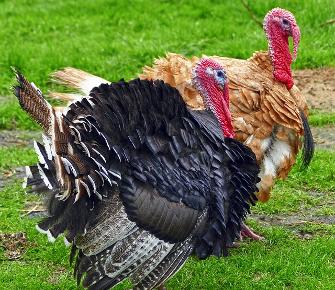
November 23, 2017
We wish a happy
Thanksgiving
To all our customers and readers!
October 31, 2017
DM Rare Coins Coin of the Month
October 2017
1950-S ProoflikeWashington Quarter: Rare Decade for this Prooflike Finish
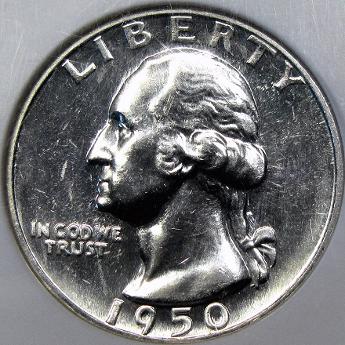
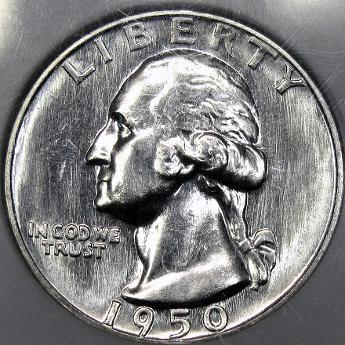
We have often discussed, here, the unique prooflike finish that appears on coins of the 1934-1954 period (See our article on the subject for more information). Dates in the 1950s are easily the most elusive Prooflikes of this period. In fact, we might have assumed that coins of these last 5 years were all but rumored to exist, if not for a few NGC pop report entries and a couple S-mint, 1950s Franklin halves that popped up in a 2003 auction at Heritage, which were never sold. Furthermore, we have personally come across a number of tantalizing, semi-Prooflike pieces from the 1950s that were struck from the early-middle die states of once fully Prooflike dies. Yet, we have not been able to find the earlier, Prooflike stages. (Also see our die state analysis article for information on die states of the 1934-1954 PL phenomenon).
Thus, when we got this amazing 1950-S Washington Quarter in hand, we could not believe it was dated to the 1950s. It looks every bit as good as the slightly more common 1940s Prooflike Washington Quarters, some of which come with outstanding mirrors and hints of Cameo, like this piece. This 1950-S easily shows the best Prooflike mirrors we have seen on any coin of this decade, and so it earns our Coin of the Month spot.
Further, the coin itself is snow white and haze free, with sharply struck surfaces that allow for optimal viewing and appreciation of the granite-like striations, polishing lines, and glassy mirrors. With this piece as a reminder that it is not hopeless, the hunt continues for Prooflike coins of the 1950s....
Happy Collecting!
Doug
DM Rare Coins
September 30, 2017
DM Rare Coins Coin of the Month
September 2017
1876/87 Misplaced Date Seated Quarter; Rarity-7 Condition Census Marvel!
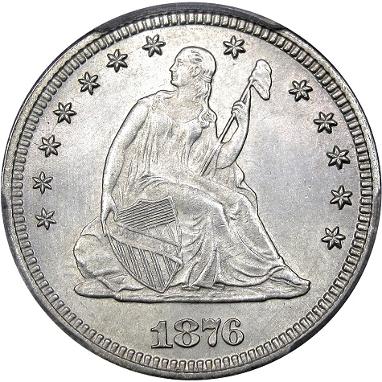
Perhaps the headline should read: Another 1876 Makes Coin of The Month! The Seated Liberty series is known for some strange die varieties, such as the so-called “Misplaced Dates,” or dies that show number punches hidden within the design. Sometimes found hidden in the folds of the drapery, the rock, and most often in the dentils, these varieties are very unusual and really do not happen in other series. Speculation about their origin ranges from playful mint workers to die sinkers needing places to rest their number punches while lining up the numerals.
The Cherrypicker’s Guide, which is always short on space, has been slow to pick up some of these extremely cool varieties. With so many different ones across this vast series, it has been hard for them to cover all of them. Only a dedicated book can do so. Quarter dollars seem to have the most Misplaced Dates, and Kevin Flynn has devoted an entire book to Seated Liberty quarter varieties, which is much more comprehensive than the Cherrypicker’s Guide. 1876, seems to have been a particularly good year for such varieties, with more than half a dozen different Misplaced Dates and Re-punched Dates are listed in Flynn (we actually contributed samples of some of them!
One of the boldest Misplaced Dates of 1876, and also one of the rarest, is Flynn MPD-004. Unlike any of the other 1876 dies, Flynn-004 clearly displays the upper loop of an 8, and the top edge of an ornate 7, hidden in the denticles below the primary date. This is the only MPD of the year with such a combination. Flynn lists this issue as a rarity 7 (3-12 known), and we have handled two of them, including what could potentially be the finest documented example, our featured PCGS MS63.
Because this variety is not found in the Cherrypicker’s Guide, PCGS does not have a catalog number to assign to it, and it receives the “Minor Variety” designation, by default. This should not be understood as a judgement of the appeal of the variety. It simply means that the Cherrypicker’s Guide has not yet included it. We have been in discussion with Bill Fivaz about its possible inclusion in the next edition. The problem is that they have to find something else to take out, if they are to fit it into the book. The Cherrypicker’s Guide is not a comprehensive reference, and perhaps PCGS should not be so reliant on it for variety attribution, in the first place.
We are excited to have this particular piece for study due to the exacting, razor blade strike and unworn, un-abraided surfaces. Very rarely are any of the Misplaced Dates found in Choice Mint State; most of those we have seen were VF or XF. This piece represents a rare opportunity to study the details of variety without the major obstacles presented by weak strike, wear, and abrasions. We hope you enjoy the pictures! More information about this and other varieties can be found in Kevin Flynn’s book, The Authoritative Reference on Seated Liberty Quarters.
Doug
DM Rare Coins
August 30, 2017
DM Rare Coins Coin of the Month
August 2017
1945 "No AW" FS-901 Walking Liberty
NGC MS66 Finest Known!
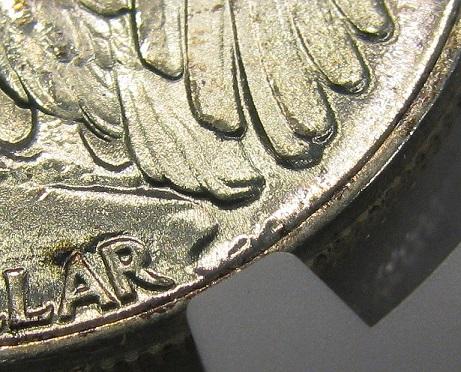
Several dates in the Walking Liberty series have been found with missing designer’s initials. The most well-known of these is the 1945 Philadelphia issue, due to its inclusion in the Cherrypicker’s Guide. These varieties are not very well-understood by most collectors, and for good reason; they are not what they seem.
The “AW” monogram (it’s actually, AAW, for designer, Adolph A. Weinman) was present on the hub used to make all Walking Liberty half dollar dies, thus it is not possible for a die to be manufactured without the AW. Excessive die polishing and die fatigue are to blame for the lost detail that results in the No AW varieties. All known examples show some faint remnant of the designer’s initials.
In the case of the 1945, the dies are found, in their earlier stages, to be heavily polished, with large patches of reflective luster where aggressive die grinding and resurfacing took place. Mint workers clipped the top left half of the AW monogram, completely removing it, while doing this restoration. Then, as the dies began to wear out, the satiny and polished surfaces began to get rough and frosty, and the remaining lower right half of the AW began to fade. The dies were still not retired at this late die state, but instead were used to strike additional coins until the lettering became indistinct and the rims began to stretch from starburst striations. This final blow stretched and distorted the already indistinct AW fragment, resulting in coins that, at a glance seem to be missing the AW altogether.
Some have said that because this is a “die state variety” and not a true mistake by the engravers, that it is not a real variety. And yet, it is popular enough to fetch almost $1000 whenever an MS64 comes to market. The reason for this popularity is that coins in this advanced die state, and which have qualified for the NO AW FS-901 designation by NGC and PCGS, are very rare in choice mint state. To date, NGC has certified 13 examples between MS63 and MS66, including 3 in MS63, 7 in MS64, 0 in MS65, and 2 in MS66. PCGS has graded 3 coins in MS63 and 1 in MS65.
The present specimen is tied with one other coin as the finest known example of the FS-901 No AW variety. This gleaming, golden toned, original MS66 is a sparkling and superlative example of the issue. Our photographs should help collectors discern what it takes to qualify for this coveted variety.
Doug
DM Rare Coins

Now stay a while; we have coupons!
7% OFF ALL FRANKLIN HALVES
Through 8/13, with offer code:
7FRANKLINS
DM Rare Coins Coin of the Month
July 2017
1876 Dickeson Continental Currency Dollar
Original Strike, HK-853, Copper. Rarity-7
PCGS MS65BN
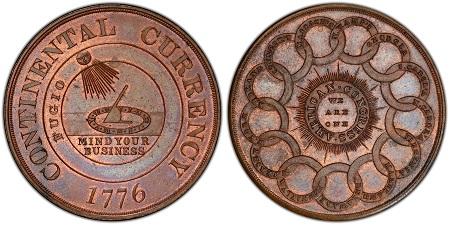
A perennial favorite among So-Called Dollar collectors, the 1876 Dickeson Continental Dollar Copy is also one of the only medals in the industry-standard, Hibler-Kappen reference that is popular enough to have its own restrikes. Buying one of these is the closest most people will ever come to owning an original Continental Dollar, after all. The historically significant, 1776 Continental Currency dollars, primarily struck in Pewter, but also existing in brass and silver, are very expensive. Low grade, damaged pieces will start around $20,000. The 19th Century Dickeson versions, and their 20th Century restrikes, are much more affordable, by comparison, at anywhere from $100 to $1000, even though the 1876 is arguably as rare as the 1776.
These were struck in celebration of the 1876 Philadelphia Centennial Exposition, at which Dickeson’s famous collection and creations were on display. These medals may have been available for purchase as souvenirs of the occasion. David Bower’s estimates that; while several hundred white metal pieces were issued; only a few dozen of the copper version were struck (Bowers, 307). Ironically, most collectors find the copper version to be more aesthetically appealing. Today only about a dozen have been certified in copper, though some of the pieces slabbed as 1876 Dickeson Continental Dollars are actually mislabeled or misidentified 1962 Bashlow Restrikes, of a much lower quality.
Unfortunately,
few have had an opportunity to own the original issue, due to its extreme
rarity. The total number of pieces slabbed as 1876 originals can be counted
on two hands. Thus, the choice original, PCGS MS65 that crossed our desk this
month was an exciting find. With unmarked, satiny gem brilliance; moderate
remaining mint red in the devices; and the crisp, intricate features; for which
the originals are known to be superior; this piece easily made our Coin of the Month spot. It is a superlative example of
this highly sought issue.
Note: Please read and bookmark our feature length article:
Distinguishing Dickeson's Dollars: 1876 Dickeson Continental Currency Dollar Imposters.
Q. David Bowers. Whitman Encyclopedia of Colonial and Early American Coins: The Only Authoritative Reference on All Pre-Federal Coinage. Atlanta; Whitman Publishing, LLC. 2009.
Doug
DM Rare Coins
DM Rare Coins Coin of the Month
May 2017
RARE DEEP MIRROR PROOFLIKE KENNEDY
1970-D NGC MS63 DPL
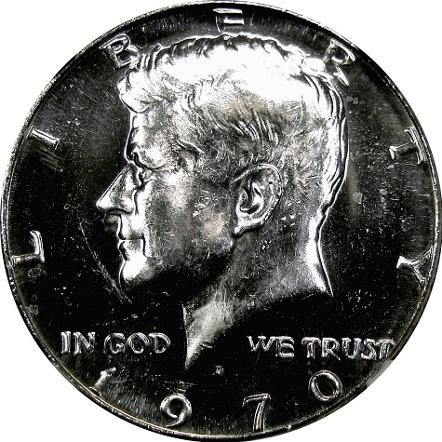
The final date in the 40% silver Kennedy half dollar series, 1970, was issued only in Mint sets and Proof sets. While most coins from these Mint sets are completely normal, frosty Kennedy halves, collectors find occasional examples with Prooflike qualities. Those with complete, uninterrupted mirrored luster over the fields of both sides are given the actual Prooflike designation by NGC. These reflective, mirrored coins result from freshly polished dies. However, there is another level of reflective luster, Deep Mirror Prooflike, sometimes abbreviated as DMPL or DPL, which is seen only rarely on coins other than Morgan Dollars. A DPL has noticeably extreme mirrors, and sometimes even Cameo contrast. Only six Kennedy halves, of any date, have been certified with the DPL designation. Five of those happen to be 1970-D.
As specialists in coins with PL qualities, we were fortunate enough to handle one of these this month, and while many might dismiss a 1970-D half dollar, out of hand, as a generic, Modern coin, the well-deserved DPL designation makes this piece both highly desirable and, in fact, a genuine numismatic rarity.
The extremely unusual finish resembles a 1970-S Proof in virtually every way, and the first inclination of the examiner is to assume it is a mislabeled 1970-S Proof. The D mint mark under Kennedy’s bust is the first thing to cause a stir of emotion. Deep, jet black mirrored fields and frosty, partially Cameo devices show over both sides, just like the typical 1970-S Proof. The deep mirrors move substantially beyond what is normally called Prooflike. Only a few coarse polishing lines on the reverse would seem out of place on a real Proof.
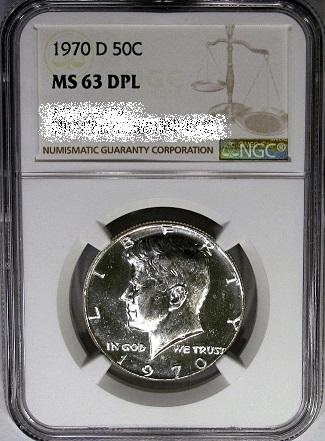
A closer inspection of the overall strike, which is not complete like it should be for a Proof, gives a clue to its true nature as a business strike. An examination of the rounded edges, under high magnification, confirms that it is a business strike half dollar and not some type of mysterious, branch mint Proof. Proofs, of course, are struck multiple times to ensure a complete strike, and the edges of Proofs will be fully raised and sharp like a knife, not flattish or rounded, as seen on this piece and all other business strikes.
This incredible coin is definitely a business strike half dollar; but one with Deep Mirror Prooflike surfaces. As such, it is extremely interesting and highly sought by knowledgeable collectors. It is probably one of the first coins to be struck on a freshly polished set of dies, or possibly even a set of retired or unused Proof dies transferred over from San Francisco that year. All five known DPLs may be from this single die, so this really is something unusual. More and more people are becoming aware of Prooflike coins in general; and their ultra-rare siblings, the DPL coins like this 1970-D half dollar, are the cream of the crop.
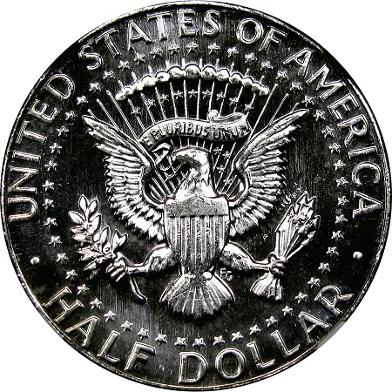
Doug
DM Rare Coins

DM Rare Coins Email Newsletter was just named a Constant Contact All Star for 2016! A warm Thank You to all our subscribers for reading and responding favorably to our emails!
"This annual award recognizes the most successful 10 percent of Constant Contact’s customer base, based on their significant achievements using email marketing to engage their customer base and drive results for their organization during the prior year."
We want to keep the steam engine rolling along through 2017, as well, but we need your help again. Without our valued customers reading our articles, submitting cool coins for study, and purchasing our numismatic treasures, we would not be able to continue.
Doug
March 9, 2017
DM Rare Coins Coin of the Month
March 2017
Rare Herennia Etruscilla Antoninianus
Over-struck on Gordian III
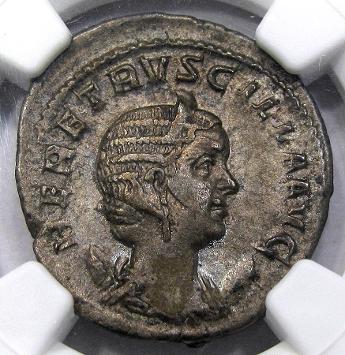
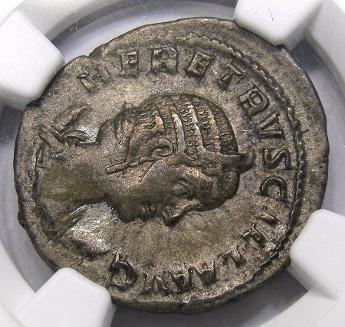
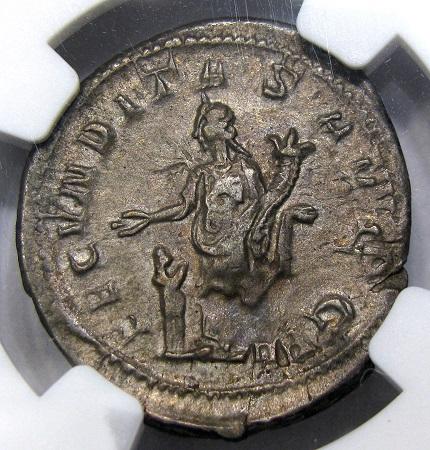
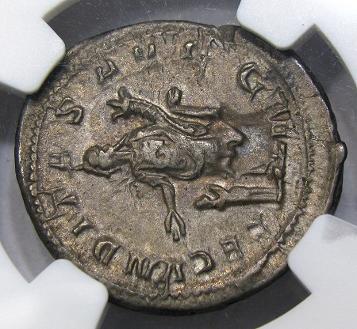
Excerpted:
Our featured Coin of the Month is a "Herennia Etruscilla Double Denarius that was over-struck on a coin of Gordian III. A diademed bust of Herennia transposed over a crescent moon is featured on the obverse in Herennia's design. The reverse motif and inscription, "Fecunditas Aug[,] honors Etruscilla as mother of two young princes," Herennius and Hostillian. (6). As a “Flipped-over Over-strike,” it is literally two coins in one, with both sides showing the head of a ruler. Struck and re-struck, roughly a decade apart, this two-headed Roman coin attests to the legacy of both Gordian III (AD 238-244) and Herennia Etruscilla (AD 249-251)."
An anchient overstrike is a cool and rare find, but this piece is very mysterious because the Herrenia Double Denarious was struck over a single Denarius of Gordian III. How could that have happen? Please read our feature-length article:
"As far as over-struck Greek and Roman coinage goes, it is superb. The surfaces display their original “find patina” and have not been cleaned or stripped like so many other examples from this period. It even shows nice original luster under the attractive toning. Moreover, the Gordian III under-type survived the striking process remarkably well, despite a very sharp, high relief strike of the Herennia design, over-top. The only strike deficiency of note is a gulf between Fecunditas’ knees and feet, where the high relief profile of Gordian III prevented her legs from showing up completely. However, this anomaly was a blessing, enabling the face of young Emperor Gordian III to show through, unscathed, even after almost 2000 years.
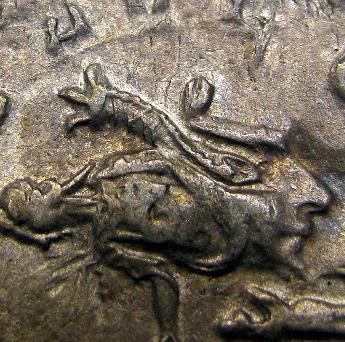
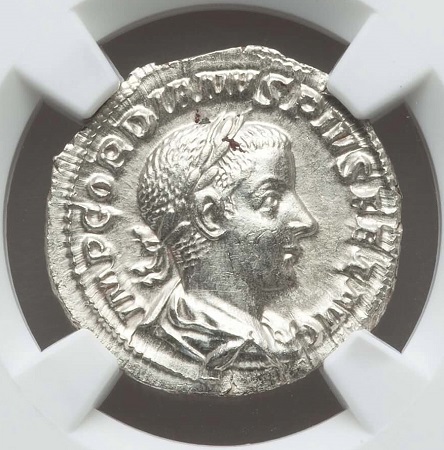
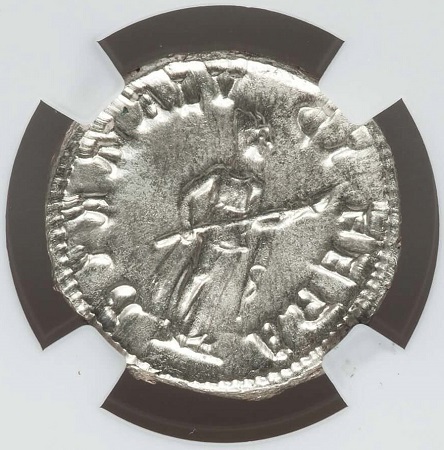
(Courtesy of Heritage Galleries)
Footnotes & Bibliography
1) The Roman Imperial Coinage: Gordian III – Uranus Antoninus. Ed. by Harold Mattingly, Edward A Sydenham, C.H.V. Sutherland. Volume 4, Part III. London; Spink and Son, LTD. 1949 (p 10). https://archive.org/stream/zingadula_20140203/RIC%204-C#page/n45/mode/2up (January 2017)
2) ibid, 113.
3) https://www.britannica.com/biography/Gordian-III
https://en.wikipedia.org/wiki/Gordian_III
https://en.wikipedia.org/wiki/Philippus_II
https://en.wikipedia.org/wiki/Decius
https://en.wikipedia.org/wiki/Volusianus
https://en.wikipedia.org/wiki/Trebonianus_Gallus
4) RIC, 10.
5) ibid, 127.
6) ibid, 115
7) ibid, 22, 27, 28.
8) ibid, 10-11.
9) ibid, 47.
10) “The weight of the coinage is indicated by the two dated types. It was slight in the months January to July 241, very heavy throughout 241-242, and still heavy in 242-3, again light in A.D. 243-4.” ibid, 10
11) ibid, 10.
12) ibid, 24-25, 27-28.
13) ibid, 25.
All Gordian III coin images used with permission from Heritage Auction Galleries:
Doug
DM Rare Coins
February 28, 2017
DM Rare Coins Coin of the Month
February 2017
Rare 1963 "OBV DIE CLASH" FS-402 Franklin!
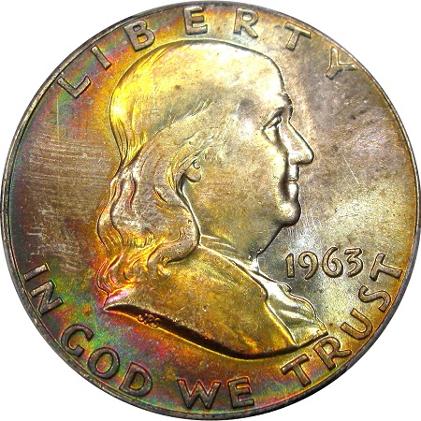
Some dates are very scarce with these designations, and the 1963-P FS-402 is a particularly tough die clash to find, especially in gem condition. It displays an up-side-down L shaped groove, or clash mark, butting up against the lip (a clash of the bottom of the eagle's wing), and a couple intermittent spikes going off at slight angles from the lip (clash lines from the eagles wing feathers).
There are only two certified in gem condition as of this month. The present PCGS CAC MS65 is currently the second finest known example, behind a single MS66. Thus, on paper, it stacks up to be a nice find; but in person, it becomes magnificent, due to the additional bonus of outstanding rainbow toning. Rarely does a gem, 1963 half dollar appear with great color like this, let alone as the second finest example of a scarce variety. It's easy to see why this piece made our February Coin of the Month! This piece is what Franklin aficionados refer to as a home run coin. A scarce variety and a scarce color-coin all wrapped up in one bundle, with a CAC sticker on top.
Doug
DM Rare Coins
January 31, 2017
DM Rare Coins Coin of the Month
January 2017
2017-P Lincoln Cent:
First Philadelphia Cent Ever to
Have a Mint Mark!
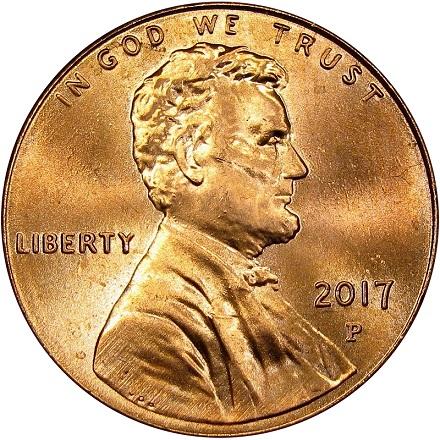
Serious collectors will likely remember where they were, and what they were buying, the first time they got a 2017 Philadelphia cent baring a mint mark. It’s one of those life or world view-altering events. There has never been a mint mark on a Philadelphia copper until this year. As the first and only U.S. Mint, for several decades, Philadelphia initially used no mint mark at all; none was needed. As other Mints were created, Philadelphia continued without mint marks until the early 1970s, when a P was added to the nickel, dime, and quarter. Out of tradition, the cent was left plain.
The Mint’s purposeful decision to keep the new P a secret fanned the flames of excitement for some presumably lucky collectors who came across them in early 2017. Hearkening back to the days of the release of the 1955 Doubled Die; which a few collectors reported finding by the roll in 1955; some thought the tall, distinctive P below the date of their shiny new cents was another major error. After all, there had been no official mention of this important modification. Others heard unsubstantiated rumors, online, of 2017 cents with no P and began the search for those, as well. Personally, my first uninformed thought was, “The Philadelphia Mint finally sold out its two-century tradition. How sad.”
In actuality, the Mint, it would seem, added the P in celebration of its 225th Anniversary and purposefully drove this hype by keeping the transformation quiet and monitoring just “how long it would take” for people to notice. Further, according to officials who finally gave up the game to Coin World Magazine on January 13th, the change is only for the year 2017. Thus, 2018 cents will go back to the traditional no-mint mark format. Finally, the modern Mint's practice of adding the mint mark to the master die was reverberated, possibly to quell rumors of With P & Without P varieties. For me, it was just a relief to learn there was a purpose behind this change and that it was not a permanent adjustment. (Gilkes)
With the creation of a one-year type, indeed a once-in-225 years-type, there is bound to be some special interest in 2017-P cents, even if they are made by the billion. High, certified grades of MS68 RD and better, are likely to be sought, even if they are not particularly rare. For that to happen, maybe we will have to wait another 225 years. Still, this is an interesting conversation piece and an entry-level collectible.
Bibliography
Gilkes, Paul. “It’s really true: Cents struck at Philadelphia Mint in 2017 bear P Mint mark.” Coin World Magazine. January 13, 2017. http://www.coinworld.com/news/us-coins/2017/01/p-mint-mark-added-to-lincoln-cent-for-first-time.html
Doug
DM Rare Coins
